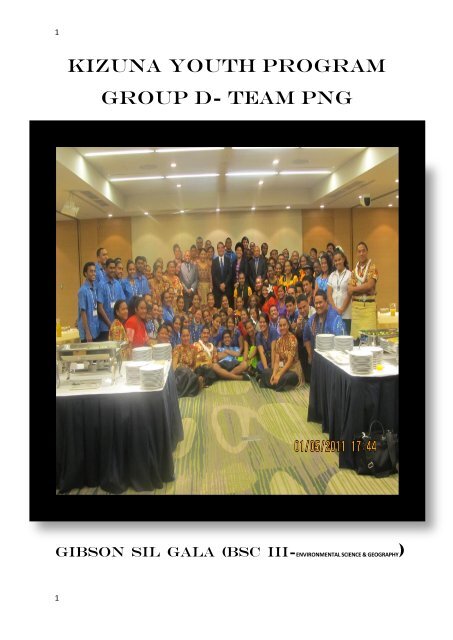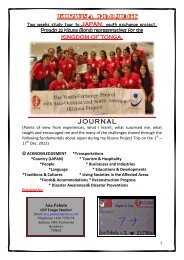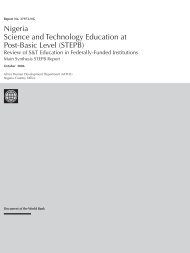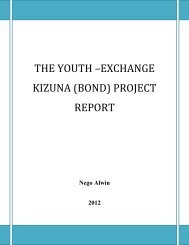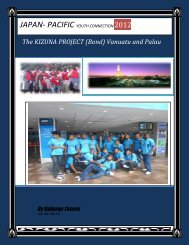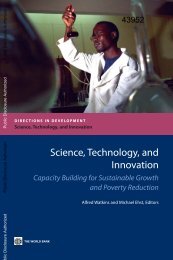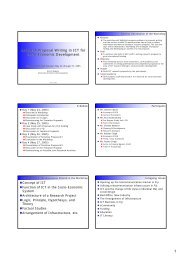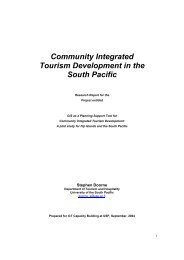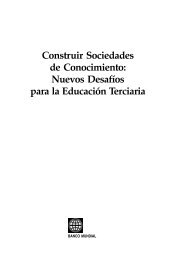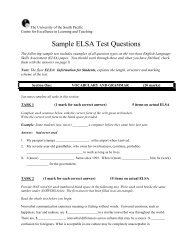KIZUNA YOUTH PROGRAM Group D- TEAM PNG - The University ...
KIZUNA YOUTH PROGRAM Group D- TEAM PNG - The University ...
KIZUNA YOUTH PROGRAM Group D- TEAM PNG - The University ...
You also want an ePaper? Increase the reach of your titles
YUMPU automatically turns print PDFs into web optimized ePapers that Google loves.
1<br />
<strong>KIZUNA</strong> <strong>YOUTH</strong> <strong>PROGRAM</strong><br />
<strong>Group</strong> D- <strong>TEAM</strong> <strong>PNG</strong><br />
GIBSON SIL GALA (BSC III-ENVIRONMENTAL SCIENCE & GEOGRAPHY)<br />
1
2<br />
CONTENT<br />
Kizuna Bond of FRIENDSHIP………………………………………………………………………I<br />
Special acknowledgment…………………………………………………………………………...II<br />
Brief History………………………………………………………………………………………………III<br />
Introduction……………………………………………………………………………………………….IV<br />
Peace message…………………………………………………………………………………………….V<br />
Restoration and recovery report………………………………………………………………..VI<br />
Environmental Management and Carbon Emission Report…………………………VII<br />
Waste Report………………………………………………………………………………………………VIII<br />
2
3<br />
<strong>KIZUNA</strong> (BOND) FRIENDSHIP MESSAGE<br />
On behalf of the 7 million people of Papua New Guinea and the<br />
22 participants of <strong>KIZUNA</strong> PROJECT 2012, may I present this<br />
report for my trip to Japan on the 1 st – 16 th of December 2012.<br />
Firstly I would like to offer my heartfelt and salute the<br />
government and the people of Japan on increasing the progress<br />
and prosperity for our bond of friendship since <strong>PNG</strong>s<br />
independence on 1975 by strengthening our ongoing bilateral<br />
relationship and creating mutual understanding of our society<br />
and culture by working together as a global community. I am<br />
most humble and honoured to say ARIGATO GOZAIMASU to the<br />
Japanese tax payers, Government of Japan and the Japanese<br />
International Cooperation (JICE) for the arranging everything and meeting the cost<br />
for the young Pacific Islanders to witness Japan’s road to recovery after the aftermath of<br />
the Great East Japan Earthquake and to reveal the facts and dispel the harmful rumours<br />
about radiation and the contamination. <strong>The</strong> relationship between our countries has<br />
been continuing to grow. Our cooperative relationship in development partnership,<br />
important economic partnership and treaty agreements such as the Kyoto Protocol and<br />
strong interpersonal networks have laid the cornerstone for our successful cooperation<br />
in a wide range of fields including health services, education investment and other<br />
infrastructure development and major environmental impact projects. <strong>The</strong>re are many<br />
to mention but let me highlight few and the major ones like the NCDC Sewerage system,<br />
NCDC waste management project which will be opening on 2015 and 15 bridges built in<br />
North Solomon’s Province and etc.<br />
It also gives me this pleasure and privileged to salute the leaders of the forty-one(41)<br />
Asia-Oceania and North America including the Government of Papua New Guinea for<br />
coming up with the agreement to help support the government and people of Japan to<br />
make things possible with an objective of promoting our country to understand Japans<br />
road to recovery by allowing our young men and women to participate in the exchange<br />
programs, visit disaster-affected areas and to bring back the knowledge to implement it<br />
in our country and also to dispel the harmful rumours that has being spoiling Japan. I<br />
believe the relationship and our bond of friendship between our countries will continue<br />
to become increasingly intimate. From this bond of friendship created within Japan and<br />
the 41 countries including <strong>PNG</strong> may I also take this opportunity to express my sincere<br />
hope that Japan and <strong>PNG</strong> will continue to develop, in particular with the earnest efforts<br />
of both countries. I wish our relationship will be further fostered in the coming years.<br />
GIBSON SIL GALA – <strong>KIZUNA</strong> PARTICIPANT 2012<br />
3
4<br />
Special Acknowledgments<br />
In this report I make a special acknowledgment to the following people for their kind<br />
support towards my trip. I would like to make a special acknowledgement to:<br />
JICE International<br />
Japanese Government<br />
Member for Sohe and V/Minister for Treasury, Hon. Delilah Gore<br />
<strong>The</strong> Gala family<br />
USP staffs and the Regional Coordinator Sera Vada-pareti<br />
Team <strong>PNG</strong> supervisor Mrs Garua Peni and Coordinator Satoru Kutsukake<br />
<strong>Group</strong> D participants (Fiji, Samoa, Tonga, Solomon Islands & <strong>PNG</strong>)<br />
<strong>The</strong> lovely and kind people of Japan<br />
People of Oro Province for Cyclone Guba Presentation.<br />
4
5<br />
BRIEF HISTORY<br />
<strong>The</strong> short-term invitation project, which represents the majority of the program,<br />
includes a 3- night and 4-day visit to areas affected by the Great East Japan Earthquake<br />
during the participants' 10-day stay in Japan. Japan International Cooperation Center<br />
(JICE) has been selected as the organization to fully coordinate the stay in order to avoid<br />
confusion and chaos caused by various inquiries and correspondences regarding<br />
managerial matters made to the disaster-affected areas by numerous implementing<br />
organizations" <strong>The</strong> Youth-Exchange Project with Asia-Oceania and North America<br />
(Kizuna (bond) Project)" is a project run by the Japanese government with the objective<br />
of promoting other countries' understanding with regards to Japan's road to recovery.<br />
<strong>The</strong> project invites young people from 41 different countries/regions in Asia-Oceania<br />
and North America, allowing them to participate in exchange programs, visit disasteraffected<br />
areas and engage in volunteer activities. It also involves sending young people<br />
from Japan to target countries/regions. Over 10,000 people are to become part of the<br />
exchange through this project.<br />
SOURCE: http://.www.jice.com<br />
5
6<br />
INTROUCTION<br />
<strong>The</strong> team <strong>PNG</strong> arrived at Narita airport on 9:45.p.m.December 1 st 2012 and travelled to<br />
Tokyo the capital city of Japan. Tokyo is the centre of Japanese politics, economy and<br />
culture. All the core management institutions, such as the head offices of government<br />
departments, companies , NGO, other private entities, administrative agencies and<br />
foreign corporations are all concentrated in the metropolitan area, while a web of road<br />
and transportation networks converge in and around the city from different directions.<br />
6
7<br />
HIROSHIMA<br />
Hiroshima Peace Memorial Museum (Japans Cry for World Peace)<br />
Japans cry for Peace began 1600s after the bombing at<br />
8:15 a.m. August 6, 1945. Japan was one of the<br />
superpowers in those days that the atomic bombing on<br />
Hiroshima turned their mind from war into peace.<br />
Hiroshima known as the city of military and education in<br />
those days launched a campaign petitioning their<br />
national government to provide assistant to build the<br />
peace memorial city and resulted in Peace Memorial City<br />
Construction Law which was stipulated that Hiroshima<br />
will rebuild and lead the world to strive for peace. As<br />
such the Peace Memorial Museum was established which<br />
thousands of tourist around the world visit to pray, to do<br />
research and also to remember the greatest tragedy in the human history. <strong>The</strong> Peace<br />
Memorial Museum was established with the mission of:<br />
o Conveying the realities of the damage caused by the atomic bomb dropped on<br />
Hiroshima<br />
o And to contribute to the abolition of nuclear weapons and the realization of<br />
everlasting world peace.<br />
Let us not reflect and remind our selves of what happened as it is a painful story that it<br />
is an unspeakable horror of the atomic bomb experience. However what I want to<br />
basically focus and emphasize in this part of my report is the appeal for peace to every<br />
men and women on this planet to join hands together and fight for peace and justice. We<br />
must reflect critically, in the clear light of objective truth, not just on the A-bomb but on<br />
war and actions that leads to war. Only with this positive attitude of determined inquiry,<br />
we will see a change and learn from our lessons of history. Let’s join hands as a global<br />
community to pray and fight for peace, and also remind our government and ourselves<br />
to stop producing nuclear weapons. Let’s be urgent of peace!<br />
7
8<br />
RESTORATION AND RECOVERY REPORT<br />
GIBSON SIL GALA (BSc III.-Environmental Science & Geography)<br />
<strong>KIZUNA</strong> PARTICIPANT -2012<br />
8
9<br />
Foreword<br />
It has taken us two weeks of continuous presentation with the Ministry of Foreign<br />
Affairs, Japanese International Cooperation Association, Yuki City authorities and the<br />
people of Japan of the plight of the restoration in Japan.<br />
This compiled document consists of a brief recovery and restoration report, nothing but<br />
report of what happened straight after the Great East Japan on March 11, 2011.<br />
I am truly thankful for the Yuki City authorities, especially the policy and planning<br />
department, the town mayor and his deputy, the people of Japan, JICE international,<br />
coordinators , the Kizuna Participants for providing all the information’s.<br />
Finally, I would like to thank my Member of Parliament for Sohe Electorate, Hon. Delilah<br />
Gore for financial assistance and the Government of Japan for opening the doors to<br />
enabling me to meet with the higher authorities in Japan to share our experiences and<br />
asses the aftermath of the greatest tragedy in the history of Japan<br />
God Bless All always,<br />
GIBSON SIL GALA<br />
9
10<br />
RADIATION AND AGRICULTURE<br />
Since the Great East Japan Earthquake, consumers in and outside of Japan have been<br />
avoiding crops products made in Yuki City, Ibaraki Prefecture because they are from<br />
Ibaraki, a neighbouring prefecture of Fukushima where nuclear accidents happened,<br />
despite the fact that radioactive content has been demonstrated to be below health risk<br />
levels. <strong>The</strong> number of tourists visiting Ibaraki has also declined drastically. Even though<br />
the atmospheric radioactive level is below health risk levels, the very name “Ibaraki”<br />
alienates sightseeing tourists. Thus, the economy of Ibaraki Prefecture has been hard hit.<br />
<strong>The</strong> term “harmful rumors” refers to this kind of prejudice toward products ad people of<br />
certain areas arising from groundless information and erroneous perceptions that<br />
results in economic and psychological damage to the affected areas. Harmful rumours<br />
are not just a physical harm, but it destroys the sovereignty and pride of a nation; and<br />
the economy and creates ill feeling among the people to hate each other. It also has<br />
serious psychological effects. In fact the government of Japan and most farmers have<br />
expressed concerns that investment in the agriculture has being declining since the<br />
disaster. In an effort to address the concern the government of Japan bought the young<br />
pacific Islanders to witness the agriculture farm and test the radiation level.<br />
<strong>The</strong>se harmful rumours have also made it an issue in the world market as well as the<br />
United Nations Food and Agriculture Organisation (FAO). <strong>The</strong> false rumour has now<br />
become an issue which every stake holder in Japan are making sure to dispel the<br />
information and give the accurate information based on scientific testings.<br />
<strong>The</strong>re is also a decline in the market of the agriculture produce for most of the farmers<br />
at Ibaraki Prefecture (Yuki City) due to the negative spill over’s from the local and<br />
international media. After going through the radiation test at the radiation level was<br />
lower than the normal radiation level which conclusions was made that their was no<br />
contamination of food. <strong>The</strong> people of Yuki City, Ibaraki Prefecture are working very<br />
hard to fight against these harmful rumors that have spread throughout Japan and<br />
abroad. <strong>The</strong>y are engaged in rent less efforts to implement many activities that promote<br />
the charms of the area and the safety of local food. <strong>The</strong>y (people) developed a platform,<br />
aimed at improving effectiveness and efficiency in the knowledge sharing and capacity<br />
development through the new and the existing systems which are functioning under as<br />
operational framework. <strong>The</strong> framework is to see that farmers and the government are<br />
working together to developing people to people understanding like the Kizuna Project<br />
to help farmers to market and advertise their produce internationally.<br />
Education (Schools)<br />
Schools were destroyed and children’s educational future was disturbed. <strong>The</strong> rumour of<br />
radiation did not even affect the students living in the affected areas. Refer to the retyped<br />
report below.<br />
10
11<br />
Health<br />
<strong>The</strong> health services were affected little (i.e. the areas that were destroyed by disaster.<br />
However during and after the disaster the health service was still provided. Refer to the<br />
retyped report below.<br />
Media<br />
Media has its rights and privileges in responding day to day events, informing general<br />
public on what is happening in the nation for the people’s interest. <strong>The</strong> Japanese media<br />
and the international media has played a vital role in informing the world about the<br />
disaster and the aftermath, however in due process, the harmful rumour about<br />
radiation was also being published due to their own perception. As a result in the event<br />
of Disaster Operations after the Great East Japan Earthquake, there was no control over<br />
the release of the news from one person, the chief controller or higher authorities as<br />
required by the laws to release news to the media. As such people reported in different<br />
perspective by giving false scientific conclusion about the food contamination from the<br />
radiation level.<br />
We are in the middle of political transition and uncertainty that’s other countries use<br />
the media to influence the world to spoil other countries as it happened in Japan.<br />
11<br />
DEBRIS MANAGEMENT<br />
<strong>The</strong> debris from the disaster was managed well, and recycled from the factories.<br />
However there are still little remains from some parts of Japan.<br />
POLITICAL SYSTEM (DECENTRALIZATION OF POWERS)<br />
<strong>The</strong> service delivery mechanism in Japan is people centred. <strong>The</strong> decentralisation of the<br />
government arms and the public services makes it more convenient for the government<br />
services to reach the people at all levels. <strong>The</strong>se make it easier when it comes for service<br />
delivery during and after disaster.<br />
Japan has an establishment of National Policies and mechanisms for each cities and<br />
towns that makes it more convenient for the actual implementation of the service<br />
delivery during and after disaster. All their policies and plans are aligned with the<br />
disaster management plans. All the government Departments, NGOs and private entities<br />
are always encouraged to integrate national and local disaster prevention and<br />
mitigation and the disaster management plan to their development policies and plans.<br />
<strong>The</strong>y also undergo some disaster drills and course to prepare themselves for disasters.<br />
<strong>The</strong>se disaster drills are made compulsory for all stake holders (see below).<br />
Good Governance Principles and Public and Policy Evaluation<br />
<strong>The</strong> governance structure in Japan operates on good governance by institutionalizing<br />
and upholding appropriate measure. This principles are essential Economic Growth. As
12<br />
such every government plan is always aligned with disaster management and<br />
environmental management plan because the two correlate together. As we know<br />
governance has become a popular way of describing how well or how badly our nations<br />
are led or governed, or how our institutions, resources and people are managed. Let me<br />
take a good picture of youths in the pacific compared to Japanese youths. Youths in the<br />
Pacific make up 50% of the regions population and are particularly vulnerable to poor<br />
Governance and corruption because youth numbers in the Pacific are growing and they<br />
are chasing fewer jobs and other opportunities and their interests as a separate group<br />
are often not a priority in Policy and Decision making because of their age and low<br />
profile, unlike Japan Empowering Human and Integral Development is the main focus of<br />
the government. This because of the following:<br />
Japan’s development problems are equal to the capabilities of government<br />
entities which do not impose a constraint on public expenditure that leads to<br />
budget deficits.<br />
Development programs are equal to Development Aspirations. Corruption is<br />
not tolerated and a leader found involving in corruption is executed as<br />
stipulated in the constitution.<br />
Developments are equal to the programs that are being instituted<br />
In every country, government is the major performer in development activities. <strong>The</strong><br />
driver of development is the Public Service. I.e. Development programs are driven by<br />
the Public Sector. <strong>The</strong>refore government and the public service work together to make<br />
sure tasks are executed within the time frame set. In Japan people do their job with all<br />
their heart and they give it to the best of their ability. <strong>The</strong>y make sure to provide the fast<br />
and effective service with honesty and integrity. Every one deserves the same respect,<br />
i.e. from the Prime Minister to a cleaner they are all respected equally with dignity and<br />
pride.<br />
12
13<br />
RETYPE REPORT FROM PROGRM CONTENT FOR IBARAKI GROUP (COPIED)<br />
IBARAKI PREFACTURE<br />
Map<br />
Nuclear power plants and industrial zones expand in the northern part of the<br />
Ibaraki Prefacture, and a science city and new towns in the southern part.<br />
Tsukuba City situated in the southern part of the research cities with as many as<br />
300 research institutions and companies with about 13,000 researchers.<br />
Ibaraki Airport was opened in March 2010. Since the Great East Japan<br />
Earthquake in March 2011, international flights arriving in and departing from<br />
Ibaraki Airport have continued to decrease or be cancelled.<br />
Employment by industries<br />
30.80%<br />
7.50%<br />
61.70%<br />
Tertiary industries<br />
Primary industries<br />
Secondary industry<br />
Unit: Person<br />
Primary industry *¹ 108,019<br />
Secondary industry *² 443,203<br />
Tertiary industries *³ 888,58<br />
*1: Agriculture and fisheries<br />
*2: Manufacturing and construction, etc<br />
*3: Commerce, finance and services, etc.<br />
Source: Waga Machi Mura (Our Town, Our Village) by the Ministry of Agriculture, Forestry and<br />
Fisherieshttp://www.machimura.maff.go.jp/machi/<br />
Population (person) 2,945,505<br />
Area (ha) 609,572<br />
Number of elementary schools 570<br />
13
14<br />
Number of elementary school children 167,945<br />
Number of junior high schools 244<br />
Number of Junior high school students 85,938<br />
Number of high schools 131<br />
Number of high school students 81,626<br />
Number of colleges/universities 9<br />
Number of college/university students 30,439<br />
Number of libraries 57<br />
Number of general hospitals 168<br />
Source: Statistical Database by Region (2008-2010) by the Ministry of Internal Affairs and<br />
Communications. http://www.e-stat.go.jp/SG1/estat/eStatTopPortal.do<br />
Disaster Damage in Ibaraki Prefecture<br />
1. Scale of Disaster<br />
-Maximum seismic intensity:<br />
6 plus; (eight municipalities, Hitachi City, Chikusei City, Kasama City,<br />
Hitachiomiya City, Naka City, Hokota City, Omitama City, Takahagi City)<br />
6 plus; (21 muicipalities: Mito City, Hitachinaka City, Tokai Village, Ishioka City,<br />
Toride City, Tsukuba City, Kashima City, Tsuchiura City, Sakuragawa City, Joso<br />
City, Hitachiota City, Kitaibaraki City, Itako City, Bando City, Inashiki City,<br />
Kasumigaura City, Namegata City, Tsukubamiria City, Ibaraki Town, Shirosato<br />
Town, Miho village)<br />
2. Overview of Damage<br />
- Overall damage: Approximately .2.5 trillion yen (as estimated in march)<br />
- Causalities: See the table below.<br />
Casualities Resulting from Great East Japan Earthquake<br />
May 9, 2012 (as announced by Ibaraki Prefectural Government)<br />
Dead (persons) Missing (persons) Severely injured<br />
(persons)<br />
Ibaraki Prefectural 24 1 33<br />
total<br />
Mito City 2 9<br />
Ryugasaki City 1<br />
Shimotsuma City 1<br />
Joso City 1<br />
Hitachiota City 1<br />
Takahagi City 1 1<br />
Kitaibaraki City 5 1 1<br />
Tsukuba City 1 3<br />
Hitachinaka City 2 2<br />
14
15<br />
Kashima City 1<br />
Namegata City 2 1<br />
Ushiku City 1<br />
Oarai Town 1<br />
Tokai Village 4 1<br />
Hitachi City 6<br />
Ishioka City 1<br />
Moriya City 1<br />
Chikusei City 1<br />
Kasumigaura City 1<br />
Hokota City 1<br />
Ibaraki Town 1<br />
Tsukubamiria City 3<br />
-Damage to residential buildings: Total destruction: 2728; partial destruction: 24,393;<br />
minor collapse or damage:182,224; inundation above floor level 1,772; inundation<br />
below floor level 771<br />
3. Evacuation<br />
Disaster shelters<br />
Ibaraki Prefecture total 594 77,285<br />
Northern prefecture 124 25,517<br />
Central prefecture 182 31,697<br />
Rokko 76 11,908<br />
Southern prefecture 141 6,953<br />
Western prefecture 71 1,210<br />
Evacuees/refugees<br />
*As of March 12, 2011<br />
*Peak inflow of evacuees/refugees from Fukushima Prefecture: 1,865 (10 a.m. March 21, Disaster shelters: 4<br />
prefectural & 23 municipal)<br />
(I)<br />
Lifeline infrastructure<br />
Situation in immediate<br />
aftermath of disaster<br />
Roads:<br />
Prefecture – managed roads closed at 133 locations<br />
Railways:<br />
<strong>The</strong> entire rail network was closed down on March 11, with service partially<br />
resuming the next day (e.g. Ueno Abiko and Ayase- Toride sections of Joban Line)<br />
Power supply:<br />
Outages in 43 municipalities, 866,000 households affected<br />
Water supply:<br />
Area –wide outages in 28 municipalities and partial outages in 11 municipalities<br />
15
16<br />
Progress in restoration<br />
work<br />
Roads:<br />
Number of closures of prefecture –managed roads reduced to 4<br />
(2/26)<br />
Railways:<br />
Service resumed throughout the Oarai-Kshima Line of Kashima Rinkai Tetsudo<br />
railway (7/23) and the Hitachinaka Seaside Railway line (7/23)<br />
Power supply:<br />
Supply fully restored (3/18)<br />
Water supply:<br />
Supply fully restored (5/7: Kamisushi City)<br />
(II)<br />
Rumor fighting measures (agriculture, forestry and<br />
fisheries)<br />
Basic Policy<br />
- To assist producers who are suffering from consumers reluctance<br />
to purchase products due to baseless rumours and depressed<br />
prices by mounting a campaign to support Ibaraki-made<br />
agricultural products in and out-side the prefecture<br />
- To assist efforts by JA and producers to assure consumers of<br />
product safety through producer-direct sales<br />
Major Efforts<br />
- Groundless rumour eradication campaign<br />
- Demonstration sale of agricultural products and processed foods<br />
- Ibaraki Food Fair 2011<br />
- Ibaraki Melon Campaign in Kobe<br />
- “Go Ibaraki” Vegetable Marketing Campaign<br />
- Ibaraki Autumn Harvest Festival<br />
16
17<br />
Major Efforts - Measurement of atmospheric radiation doses (all<br />
municipalities)<br />
- Regular radiation testing for the safe and secure supply of<br />
agricultural, forestry and fisheries products(number of<br />
radioactive materials, screenings of agricultural, fisheries<br />
and forest products): 191 items, 12,762 specimens (as of<br />
January 31)<br />
- Water quality monitoring of tap water<br />
- Measurement of radioactive materials in a sewage slug, etc.<br />
- Measurement of atmospheric radiation doses at prefectural<br />
urban parks (19)<br />
- Distribution of simple radiation measuring instruments to<br />
municipal governments and holding of briefing sessions on<br />
their use<br />
- Preparation of a guide to simple decontamination<br />
- Holding of lecture meetings o the health impact of<br />
radiation (cohosted with municipal governments)<br />
- Dispatch of radiation advisers<br />
- *Measurements results are available at the prefectural<br />
government website:<br />
- http://www.pref.ibaraki.jp/<br />
(iv) Rumour fighting measures<br />
Basic Policy<br />
- To rebound from the sharp fall in tourist visits due to direct<br />
disaster damage to tourist and accommodation facilities,<br />
groundless rumors and some potential tourists’ self imposed<br />
tourism moratorium as soon as possible<br />
- To foster more attractive tourist destinations than before the<br />
earthquake and thereby entice more tourists in cooperation with<br />
the municipal governments and tourism organisation<br />
17
18<br />
Major Efforts<br />
- Ibaraki Around the Prefecture Tourism Promotion program<br />
designed to provide tourism companies and others with tourism<br />
buses on an aid in kind basis<br />
- “Rediscover Ibaraki! Autumn Night Stay Promotion Campaign”<br />
targeted at prefectural residents<br />
- Holding of “Ibaraki Gourmet Festival”<br />
- Regular publishing of Tourism Ibaraki in antique tile-engraving<br />
style<br />
- Tourism campaigns and product fairs in and outside the prefecture<br />
- “Train Channel” digital sinage advertising o Yamanote, Keihin<br />
Tohoku and other railway lines<br />
- Targeted information delivery to foreign tourists and invitation of<br />
overseas media organisations.<br />
18
19<br />
SOURCES:<br />
- “Chronicle of Disaster Recovery and Restoration Activities on Public<br />
Infrastructure in Wake of Great East Japan Earthquake” by Public Works<br />
Department, Ibaraki Prefectural Government<br />
http://www.pref.ibaraki.jp/cms/doboku/hotnews/toshis0_20120323/index.ht<br />
ml<br />
- “Great East Japan Earthquake and Its Aftermath (as of 9.00, may 9)”by Ibaraki<br />
Prefectural Government<br />
http://www.pref.ibaraki.jp/importat/20110311eq/20120509_01/index.html<br />
- Message from Ibaraki Prefectural Governor (March 30,2011)<br />
http://www.pref.ibaraki.jp/20110311eq/message.html<br />
- Ibaraki Prefectural Government Newsletter, March 2012 Issue<br />
http://www.pref.ibaraki.jp/hibari/2012_03.html<br />
19
20<br />
Yuki City<br />
<br />
<br />
<br />
Yuki City is located on the west side of Ibaraki Prefecture and ext to the<br />
Kanugawa River. From the city, you can view Mt. Tsukuba to the east and the<br />
Nikko mountain range to the northwest.<br />
A castle was built at the end of the 12 th century, and the atmosphere of the castle<br />
town still remains in the city.<br />
<strong>The</strong> city is known throughout the country as the home of the hand-woven textile<br />
Yuki-tsumugi.<br />
Employment by industries<br />
8.80%<br />
53.10%<br />
38.00%<br />
Primary Industries<br />
Secondary Industries<br />
Tertiary industries<br />
(Unit: Person)<br />
Primary industries 2411<br />
Secondary industries 10383<br />
Tertiary industries 14506<br />
*1: Agriculture and fisheries, etc.<br />
*2: Manufacturing and construction, etc<br />
*3: Commerce, finance and services, etc.<br />
(Source) Waga Machi Waga Mura (Our Town, Our Village) by the Ministry of Agriculture, Forestry and Fisheries<br />
http://www.machimura. Maff.go.jp/machi/map/map1.html.<br />
Population (persons) 52,460<br />
Area (ha) 6,584<br />
Number of elementary schools 9<br />
Number of elementary school children 2,839<br />
Number of junior high schools 3<br />
Number of junior high school students 1,465<br />
20
21<br />
Number of high schools 3<br />
Number of high school students 1,365<br />
Number of libraries 1<br />
Number of general hospitals 2<br />
(Source) Statistical Database by Region (2005-2007) by the Ministry of Internal Affairs and communications.<br />
http://www.estat.go.jp/SG1/eStatTopPortal.do.<br />
Damages Yuki City Sustained and the Ongoing<br />
Reconstruction<br />
On Friday, March 11, 2011 at 2:46 p.m., an earthquake of magnitude 9.0, the biggest<br />
ever recorded in Japan, hit the country with the epicentre off SANRIKU coast. It hit<br />
Yuyki City with an intensity of 5 upper on the Japan Meteorological Agency Scale,<br />
causing substantial damage throughout the city. By the end of the day, the city set up a<br />
Disaster Response Headquarters headed by the mayor, and worked hard to grasp the<br />
extent of the damage and provide initial responses. For a few days, the city water supply<br />
was interrupted or suffered turbidity. Nearly half of the city suffered a black out.<br />
People’s lives were seriously inconvenienced.<br />
<strong>The</strong> damage incurred by the city (as of March 22, 2011) included 1,161 fallen concrete<br />
block fences, 2,849 damaged tiled roofs and many damaged house structures. <strong>The</strong><br />
damages extended across the city. Damaged public facilities included the City Office<br />
building, eight elementary schools, three junior high schools, the Yuki Cultural Centre<br />
“Across”, the Yuki Public Information Centre, Kanakubo Sports Complex (multi-purpose<br />
gym, second gym and martial arts hall), Sewer Treatment Centre, other meeting and<br />
community service centres and 23 city roads.<br />
[Harmful rumors: Agriculture]<br />
What are harmful rumours?<br />
Since the Great East Japan Earthquake, consumers in and outside of Japan have been<br />
avoiding crops products made in Yuki City, Ibaraki Prefecture because they are from<br />
Ibaraki, a neighbouring prefecture of Fukushima where nuclear accidents happened,<br />
despite the fact that radioactive content has been demonstrated to be below health risk<br />
levels. <strong>The</strong> number of tourists visiting Ibaraki has also declined drastically. Even though<br />
the atmospheric radioactive level is below health risk levels, the very name “Ibaraki”<br />
alienates sightseeing tourists. Thus, the economy of Ibaraki Prefecture has been hard hit.<br />
<strong>The</strong> term “harmful rumors” refers to this kind of prejudice toward products ad people of<br />
certain areas arising from groundless information and erroneous perceptions that<br />
results in economic and psychological damage to the affected areas.<br />
<strong>The</strong> people of Yuki City, Ibaraki Prefecture are working very hard to fight against these<br />
harmful rumors that have spread throughout Japan and abroad. <strong>The</strong>y are engaged in<br />
rent less efforts to implement many activities that promote the charms of the area and<br />
the safety of local food.<br />
21
22<br />
ENVIRONMENTAL MANAGEMENT AND CARBON EMMISION REPORT<br />
GIBSON SIL GALA (BSc III) - ENVIRONMENTAL SCIENCE AND GEOGRAPHY<br />
22
23<br />
Introduction (Japans Commitment to Environmental Justice)<br />
Although Japan is a well developed country in the world that is faced with traffic<br />
congestion, pollution problems and high carbon emissions as claimed by other nations,<br />
the dilemma has changed in this era as the nation is looking into building the worlds<br />
confidence by fighting for environmental justice in redesigning all their factories<br />
resilient to carbon emissions and also promoting renewable energy. <strong>The</strong> nation’s effort<br />
was supported when they introduced the Kyoto Protocol and ratified by other nations in<br />
the world to reduce carbon emissions. Japan is more committed with the fight of climate<br />
change. In the recent meeting held for future climate-protection framework at Doha,<br />
Japan took the lead to encourage the world’s two largest emitters (China and USA) to<br />
take part in the global climate protection system that would be agreed to before 2015<br />
and to include both developing and industrialised nations. According to Masahiko Horie<br />
the country’s ambassadors for global environmental affairs,<br />
Japan is acting now to pave the way for green, resources-friendly cities that will avoid<br />
them from facing a bleak and environmentally degraded future. Japan has seen<br />
unprecedented urban population growth but this has been accompanied by the<br />
immense stress on the environment. <strong>The</strong> challenge they are taking now is to put in place<br />
policies which will reverse that trend and facilitate the development of green<br />
technology and green urbanization by encouraging all booming cities to go green. <strong>The</strong><br />
government is taking the responsibility to adapt policies that can encourage green<br />
economy, green technology and green urbanization for the betterment of their future.<br />
This part of the report is basically focusing on environmental plan and management of<br />
the places we visited.<br />
Shinagawa Incinerator Plant Environmental Plan and Commitment<br />
<strong>The</strong> second principle for the Plant is redesigned and reconstructed according to Ecofriendly<br />
Designed. According to the Shinagawa Incinerating Plant pamphlet, the plant<br />
was designed is equipped with the latest pollution control facilities such as:<br />
Bag filters<br />
Gas scrubber &<br />
DeNOx reactor<br />
<strong>The</strong>y remove airborne pollutants such as hydrogen chloride, sulphur oxides and<br />
nitrogen oxides (see below)<br />
23
24<br />
Pollution control standards<br />
Regulated Maximum<br />
Values<br />
Self-imposed Maximum<br />
Values<br />
Particulates 0.04g/m³N 0.01g/m³N<br />
Hydrogen Chloride<br />
700mg/m³N<br />
10 ppm<br />
(430 ppm)<br />
Sulphur oxides<br />
369.87 m³N/day<br />
10ppm<br />
(regulated total emissions) (61 ppm)<br />
Nitrogen<br />
oxides<br />
Regulated total<br />
emissions<br />
18.67 m³/N/hour 13.07 m³N/hour<br />
(one- hour daily<br />
average)<br />
Regulated 250 ppm 50 ppm<br />
concentrations<br />
Mercury - 0.05 mg/m³N<br />
Dioxins 0.1ng-TEQ/m³N -<br />
Waste water 10 pg-TEQ/L -<br />
Source: Waste Report 2012<br />
<strong>The</strong> Environmental Measures to counter exhaust and wastewater emissions<br />
Organic Farming<br />
As part of the countries commitment to fighting climate change and environment<br />
pollution, Japan encourages organic farming. Organic farming is not commonly practise<br />
in the world but Japanese farmers at Hiroshima are applying these skills. “I love my wife<br />
and nature” said a farmer at Hiroshima.<br />
Tokyo Sewerage Environmental Commitment and Plan<br />
<strong>The</strong> Sewage system plays a vital role in ensuring a safe and a pleasant environment and<br />
in a makeup of water circulation system. It also helps to remove water from the land<br />
surface apart from cleaning of the water. <strong>The</strong> goal of the sewerage system is to:<br />
a. Improve the Living Environment through Sewage Treatment<br />
b. Preventing Flooding through the rainwater drainage<br />
c. Preservation of Water Quality of Public water bodies<br />
d. And supplying of reclaimed water to “Seseragi”<br />
<strong>The</strong> Management has a policy that is much friendlier to the environment. <strong>The</strong>re are<br />
three basic policies but policy 1 & 2 basically focuses on environment.<br />
a. Policy 1: Ensuring a safe and comfortable living environment<br />
b. Policy 2: Contribute to a hospitable and environmentally beneficial water<br />
environment.<br />
c. Policy 3: Provide the best service at the lowest cost<br />
24
25<br />
Plan Overview<br />
Ensure a safe and comfortable living<br />
environment<br />
Reconstruction of Facilities<br />
Contribute to a hospitable and<br />
environmentally beneficial water<br />
environment<br />
Global Warming Countermeasures<br />
Flood Countermeasures<br />
Improvement of Combined Sewer System<br />
Advanced Treatment<br />
Disaster Management<br />
Use of Resources<br />
Maximize our ability to provide responsible and economical service<br />
“Provide the best service at the lowest cost”<br />
Source: SEWERAGE in TOKYO (Bureau Of Sewerage Tokyo Metropolitan<br />
Government)<br />
o Conclusion<br />
<strong>The</strong> environment provides goods and services that sustain human development so we<br />
must ensure that development sustains the environment. Scientist have an independent<br />
obligation to reveal the truth as we see and separating the truth from the fiction and<br />
revealing the truth is very important. We have to take into consideration other people<br />
and must not be greedy because greed is a major issue that is affecting the environment.<br />
25
26<br />
WASTE REPORT<br />
<strong>TEAM</strong> <strong>PNG</strong>- <strong>KIZUNA</strong><br />
WASTE MANAGEMENT AND RECYCLING REPORT FOR (SHINAGAWA INCINERATING PLANT)<br />
GIBSON SIL GALA – ENVIRONMENTAL SCIENCE AND GEOGRAPHY III<br />
26
27<br />
Introduction<br />
Everyday we produce refuse in our lives. <strong>The</strong>refore it is very important and essential<br />
that we must minimise the generation of the refuse in general; promote the sorting of<br />
the refuse and recycling, and treat them appropriately. <strong>The</strong> Clean Association of<br />
TOKYO23 is a special local government body established after several debates from the<br />
Tokyo metropolitan government and the 23 cities based on the Local Autonomy Act, to<br />
jointly manage waste treatment. From the agreement Japan has 20 Incineration plant<br />
operating except Nerima Incinerating Plant which is currently under renewal of the<br />
facilities. This report will basically be looking at Shinagawa Incinerating Plant which we<br />
visited.<br />
Shinagawa Incineration Plant is located in Shinagawa at Tokyo and was completed in<br />
March 2006 with a property area of approximately 47,000 m² (Type A). It has a stack<br />
height of 90m and has been completely redesigned and reconstructed according to<br />
three basic principles:<br />
o Implementing eco-friendly design<br />
o Maintaining harmony with urban planning and,<br />
o Promoting the nations commitment to recycling.<br />
<strong>The</strong> goal of the plant is to:<br />
o Support the national commitment to recycling by safely and securely treating the<br />
huge amounts of refuse that are delivered to the Plant daily and<br />
o To use our limited resources to and energy effectively while protecting the<br />
environment of the neighbouring community<br />
Waste Management Administration<br />
i. Regulations on Waste Management<br />
Japan has waste management policy and is strictly coordinated by the Clean Association<br />
of TOKYO23 however the control and the administration of waste collection is given to<br />
respective 23 cities but work in collaboration for the waste processing because some<br />
cities does not have the facilities. <strong>The</strong> policy is to be used to ensure effective<br />
management of all forms of waste in the 23 cities. By-Laws have also being enacted by<br />
Local Autonomy Act.<br />
27
28<br />
Types of work conducted by the each of the 23 cities.<br />
Community<br />
Development<br />
Social Welfare<br />
………………………….<br />
Disaster prevention<br />
Industrial promotion<br />
Waste management operation<br />
Waste collection and<br />
transportation, recovery of<br />
resources, etc.<br />
Immediate waste processing<br />
(incineration and<br />
pulverization), sewage<br />
treatment, etc<br />
Final treatment (landfill)<br />
Managed by each of the cities<br />
Managed by the Clean<br />
Association of Tokyo 23<br />
Managed by the Tokyo<br />
metropolitan government<br />
as consigned by the cities<br />
and the Clean Association<br />
of TOKYO 23<br />
Source: Tokyo Waste Report 2012 (Towards a recycling society)<br />
ii. Definition of Waste and its classification<br />
A simple definition of waste would be unwanted material or any material that has<br />
exhausted all its normal forms of functions and purpose. <strong>The</strong> Waste Management<br />
Division has specifically classified waste within the city into six (6) main categories:<br />
Industrial and Commercial Waste<br />
<strong>The</strong> source of this category of waste is from Industrial, commercial premises,<br />
construction sites, shipyards and mechanical workshops.<br />
Domestic Waste<br />
This category is from residential premises and constitutes about 60% of the total refuse<br />
output (solid waste).Refuse generated from public office premises and foreign<br />
embassies are also categorized as domestic waste.<br />
Schools and Institutional Waste<br />
Waste generated from all public and private run schools and institutions.<br />
Market Waste<br />
28
29<br />
Waste generated at all markets (main/mini) is categorized as Market waste. This<br />
particular waste is in its RAW stage; materials include banana leaves, coconut husks,<br />
barks etc that all organic and are highly biodegradable.<br />
Village and Settlement Waste<br />
This category of waste is from villages within the city boundaries, which are serviced by<br />
the Municipal Authorities. Settlement waste is from settlements or shanties within the<br />
city boundaries also.<br />
Health Care (Medical) Waste<br />
This particular waste is classified as hazardous due to its nature. However, despite the<br />
nature, collection and disposal method used is crude tipping (dig, burn and cover) with<br />
cover material.<br />
Others<br />
This category of waste is generated from public places such as bus stops, shopping<br />
centers and malls, parks, recreational areas and beachfronts.<br />
3R EXERCISE<br />
3R is the keyword to a life of reducing waste and cherishing resources. <strong>The</strong> 3R is<br />
referring to:<br />
a. REDUCE- Reduce what becomes waste<br />
b. REUSE- Use it again without disposing of it<br />
c. RECYCLE- Recover it as a resource<br />
WASTE MANAGEMENT SITUATION IN THE CITY<br />
II.3.1 Waste Quantity and Characteristics<br />
Over the years, Tokyo has gone through a period of rapid urbanization and<br />
industrialization. This has brought about a wide range of urban environmental<br />
problems which include escalating domestic, commercial and industrial waste out put.<br />
With a continued population growth and high influx of people from all over the world,<br />
the refuse out put is ever increasing, however with the increase of technology all this<br />
waste is treated well. Nothing is a waste in Tokyo today because everything is recycled.<br />
Amount of waste per day<br />
<strong>The</strong> estimated amount of waste generated per day is 886g. <strong>The</strong> amount of waste<br />
generated includes business waste.<br />
29
30<br />
Waste Management Budget (FYI 2011 BUDGET)-73.31 billion yen<br />
Revenue<br />
0.50%<br />
54.80%<br />
15.60%<br />
27.50%<br />
1.60%<br />
Carryover<br />
Subsidy<br />
Fees,electricity sales, etc<br />
Allotments<br />
Other<br />
Source: Waste Report 2012- Towards a recycling society<br />
Expenditure<br />
7.50%<br />
17.10%<br />
5.40%<br />
Public loan<br />
Plant maintenance cost<br />
Waste management cost<br />
Other<br />
70%<br />
Source: Waste Report 2012- Towards a recycling society<br />
Charges;<br />
<strong>The</strong> normal waste management charges or garbage bills are systemically done through<br />
the Clean Association of Tokyo 23 who charges bills to large size waste and business<br />
waste for waste services that are provided by the municipal authority. However the<br />
charges in the 23 cities are principally free for household waste.<br />
30
31<br />
Waste Collection and Transportation<br />
<strong>The</strong> Division’s Waste Removal Services within the city are conducted by city authorities<br />
and private companies contracted to the Commission. <strong>The</strong> Clean Association of Tokyo<br />
23 supervises the collection, transportation and disposal of all types of wastes within<br />
and out of the city boundaries of Tokyo.<br />
o Collection<br />
Each city has its own schedules and designated areas for collecting waste depending o<br />
the type of waste and conducts efficient work, and the drafting work plans that<br />
correspond to seasonal changes and regional trends in waste amount.<br />
o Transportation<br />
<strong>The</strong> method of transportation depends on each city depending on each type and<br />
conducts transportation work.<br />
Wastes are collected in three different categories:<br />
1. Combustible waste<br />
2. Incombustible waste<br />
3. Large- size waste<br />
Intermediate Treatment of Waste<br />
<strong>The</strong>re is intermediate treatment of waste before disposal at the plants and there is<br />
integrated Solid Waste Management System in place, including recycling program or<br />
hazardous waste treatment facilities. <strong>The</strong> use of the 3Rs and other treatment for waste<br />
reduction is at its maximum because of countries legislation and policies that are in<br />
place.<br />
Final Disposals & Landfills<br />
<strong>The</strong> final disposal and landfills of the garbage are at the factory where it is recycled<br />
again.<br />
31
32<br />
(Above). Dumping place in <strong>PNG</strong>. Above is Baruni dump. Open pit dump where<br />
rubbish is dumped and not treated.<br />
(Below).Shinegawa Incinerating Plant, the final dumping place of waste in Japan.<br />
Generating Electricity from Waste<br />
Japan is also joining Green Asia Global Corporation by turning the waste to energy (WTE)<br />
through the use of modern technologies, which will help decrease waste volume, and<br />
generate electricity as well.<br />
Conclusion<br />
In the view of this waste management report for Japan I wish the NCDC waste<br />
management project initiated by the JICA will eventuate in 2015 with the full support<br />
from Japan.<br />
RECOMMENDATION<br />
<strong>The</strong>re is currently no intermediate treatment of waste before disposal at the<br />
open dumps and no integrated Solid Waste Management System in place,<br />
including recycling program or hazardous waste treatment facilities in <strong>PNG</strong>,<br />
therefore Japanese government should give immediate assist in building this<br />
facilities.<br />
<strong>The</strong> use of the 3Rs and other treatment for waste reduction is at its minimal<br />
however, Private small scale treatment facilities have only recently being<br />
established in Port Moresby and is slowly moving to other major centers in the<br />
country, who recycle non ferrous metals and aluminums and have also greatly<br />
contributed to the minimization of such waste input into the dump sites.<br />
<strong>The</strong> only method of disposal used in the urban areas and in <strong>PNG</strong> for that matter,<br />
is crude dumping (open dumping), hence, the Japanese Government through JICE<br />
International must give training or courses that would further enhance and<br />
32
33<br />
broaden our skills and knowledge to plan and implement practical concepts and<br />
methods in our efforts to control and minimize waste.<br />
Recently, a project proposal has been submitted to JICA for technical assistance<br />
in the rehabilitation of the existing open dump into a semi aerobic system in the<br />
Capital city of<br />
<strong>The</strong>re is no integrated Solid Waste Management System in place , including<br />
intermediate treatment like recycling program, or hazardous waste treatment<br />
facilities, composting etc in <strong>PNG</strong>. Toxic wastes disposed off are in line with<br />
Department of Conservation’s relevant laws and regulations. <strong>The</strong>refore the<br />
government of Japan should give technical advice and assist the <strong>PNG</strong> government<br />
to draft all policies and legislations according to our enacted Acts and<br />
constitutions.<br />
However, major companies involved in production and distribution of toxic<br />
waste have put in place options of disposals and treatment facilities in<br />
accordance with Department of Environment & Conservation Laws and<br />
Regulations.<br />
<strong>The</strong> Japanese Government through negotiation with the <strong>PNG</strong> government should<br />
train our young university students, especially students who are majoring in<br />
Urban Planning and Management, Environmental Science to fully utilize the skills<br />
in the country because the country lacks experts in this field.<br />
33


